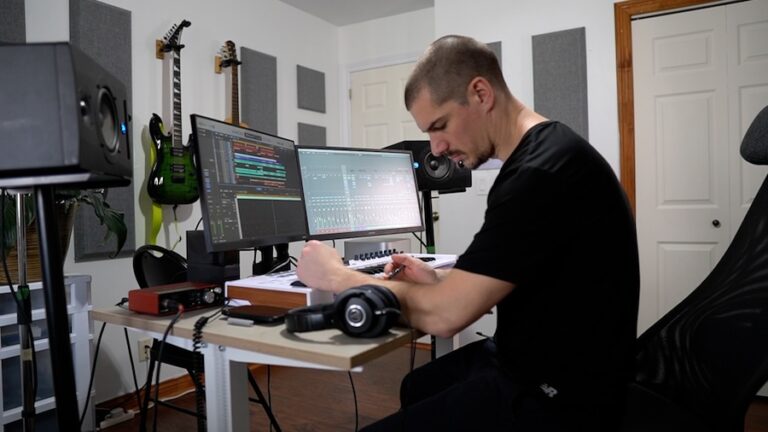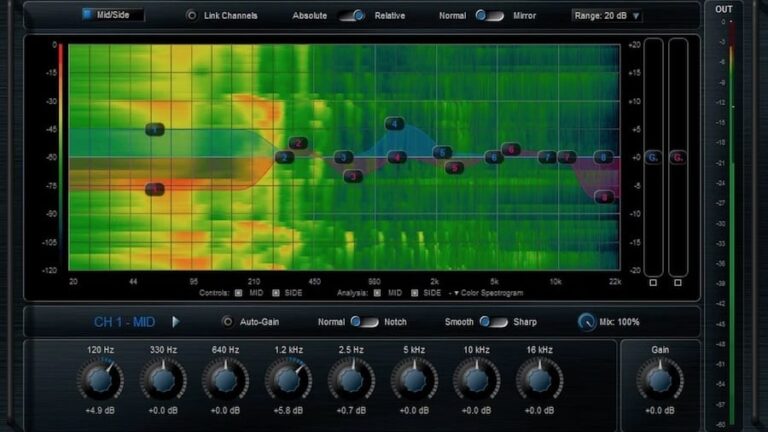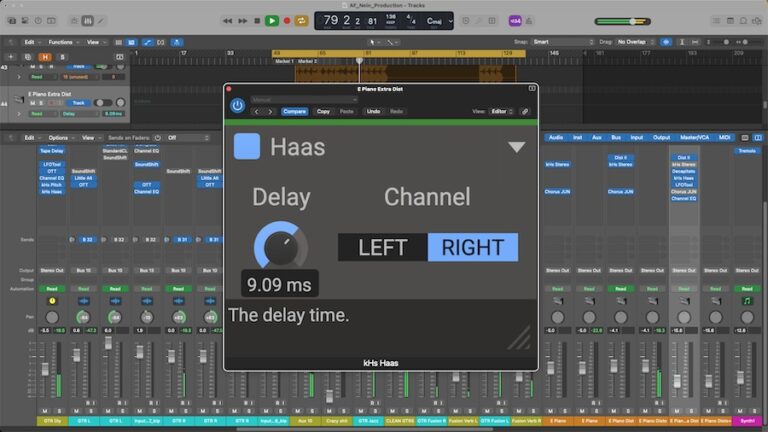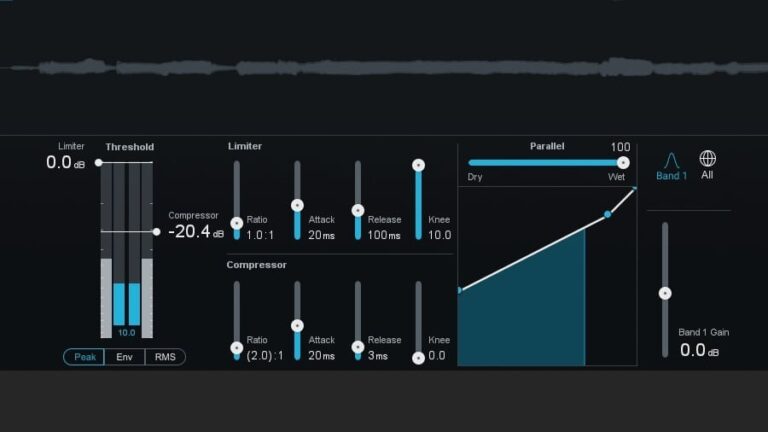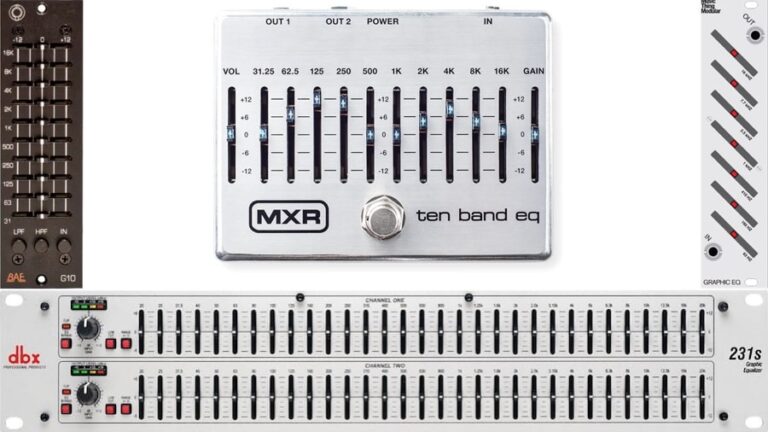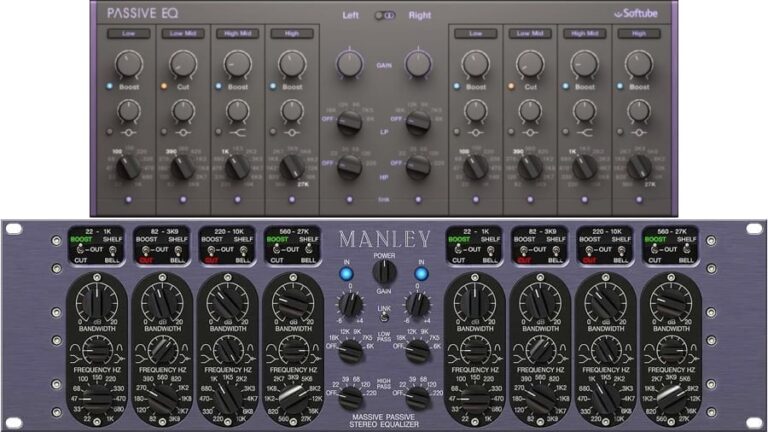Complete Guide The Tremolo Audio Modulation Effect
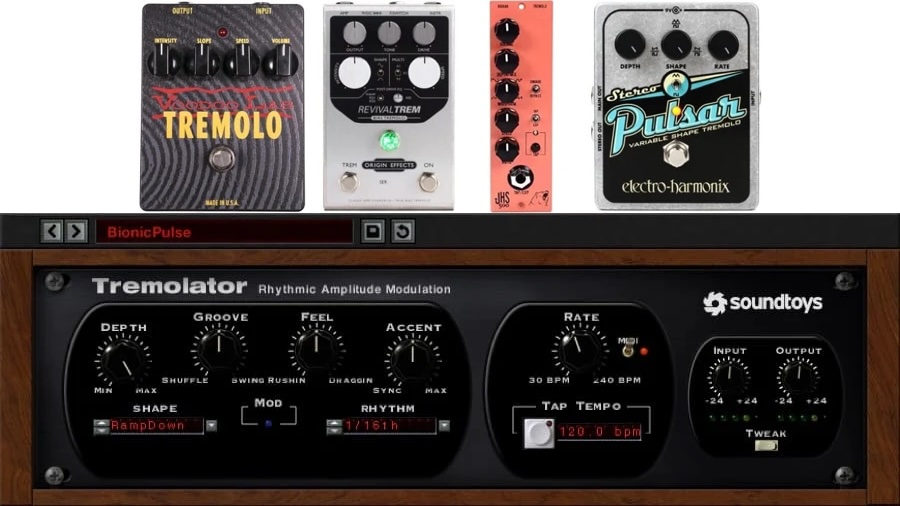
The tremolo effect is a staple in audio production, known for adding rhythmic modulation to sounds. This classic effect, characterized by rapid changes in volume, has been used across genres to create dynamic textures and captivating sonic landscapes. It translates very well to audio signals, where electrical circuits and digital programs can achieve the same effect from subtle to extreme fashion.
What is the tremolo effect in audio? Tremolo is a fast variation in amplitude. Tremolo is similar to vibrato, except that it acts on amplitude/level rather than pitch. The tremolo audio effect utilizes a low-frequency oscillator to modulate the amplitude of the audio signal.
In this article, we'll discuss the tremolo effect in greater detail and how it's achieved with audio technology. We'll touch on natural tremolo as well as a few tremolo audio effect units to deepen our understanding of the effect.
What Is The Tremolo Effect?
Tremolo (sometimes referred to as tremolando) is, as we've discussed, a noticeable variation in the amplitude or volume of a sound or audio signal. By varying the amplitude of a sound wave or audio signal in one way or another, tremolo aims to achieve a sort of “trembling” effect.
Tremolo can be achieved in several different ways, and we'll discuss the acoustic and electrical methods in this article. We'll pay special attention to electrical tremolo as this is the modulation audio effect we're most concerned with in this particular article.
The tremolo effect, in audio, aims to mimic acoustic tremolo by effectively altering the amplitude of the audio signal in a cyclical fashion. Tremolo units, then, are responsible for reducing and reintroducing signal levels to the output of the unit. These modulation effect units utilize low-frequency oscillators (LFO) to control the amplitude/attenuation circuit/program.
An LFO is an electrical oscillator with a frequency below the audible range of human hearing (below 20 Hz). Typical tremolo LFO frequencies are between 3 and 10 Hz though they may certainly extend past this range. The range depends on the particular tremolo unit.
The varying amplitude of the LFO will cause a proportional variation in the program signal of the tremolo effect. Therefore, the frequency of the LFO determines the speed or rate of the tremolo effect, and the relative amplitude of the LFO affects the relative intensity of the tremolo effect.
The following illustration shows the basic effect of tremolo by showing an input/program signal, an LFO and the resulting output signal (that is affected by the tremolo effect):

To help visualize, we can imagine the tremolo effect as someone turning a volume knob up and down very quickly. The rate and extent/range by which the knob would be turned up and down in this example are defined by the tremolo effect's speed/rate and intensity, respectively. In tremolo units, an LFO is used instead of the person in our example.
There are two main varieties of tremolo effects units. They are:
Before we get to these tremolo unit designs, let's quickly discuss acoustic tremolo to improve our general understanding of the effect.
A Note On Acoustic Tremolo
This article is largely focused on the tremolo audio effect and, therefore, the electrical side of tremolo. However, to improve our understanding, we should consider instances of natural/acoustic tremolo.
In acoustics, tremolo can happen in one of two ways, both of which act to modulate the volume rapidly. These methods are:
Rapid Reiteration
Rapid reiteration tremolo, as the name would suggest, is a style of tremolo in which a note/sound is rapidly repeated so that the transient of the sound (the fast peak and drop off of amplitude) produces a sort of tremolo effect.
Examples of rapid reiteration include the tremolo picking/plucking/bowing of strings on stringed instruments and rapid striking/rolling of percussive instruments.
As we've mentioned, the repeating transients achieve the tremolo effect in rapid reiteration techniques.
Transients are defined as the high amplitude, short-duration peaks in the sound wave (or audio signal) at the very beginning of a note/hit. They often hold much of the harmonic character and overall timbre of the sound source.
Here's a visual representation of a transient to help with the understanding of rapid reiteration:

By producing transients in very close succession, we can create a situation where a new transient is produced before the original sound amplitude envelope fully fades out. This will yield a style of tremolo.
Let's consider a visual representation of the previously-described transient being repeated:

This variation in level can be considered tremolo. More specifically, it is considered rapid reiteration tremolo.
Amplitude Variation
The other type of tremolo happens with amplitude variation. The tremolo audio effect happens electrically and is also the working principle behind many acoustic tremolo techniques.
Acoustically, this style of tremolo is easily achieved by controlling the air within a tube/pipe. Tremolo can be achieved in organs via a tremulant, in woodwind and brass instruments by controlling the amount of air being blown, and in the human voice (though vocal “tremolo” most often refers to a vibrato technique). Amplitude variation can also be achieved with bowed strings by altering the velocity at which the string is bowed.
Signal Modulation Tremolo
Signal modulation tremolo is the more popular of the two main analog designs mentioned above.
The signal modulation tremolo circuit uses its LFO to control an opto-isolator or optical assembly.
An opto-isolator is an electrical component that has 4 electrical leads. Two leads connect to an internal lamp that produces light, and the other two leads connect to a light-dependent resistor (LDR).
A light-dependent resistor, as its name would suggest, is photo-sensitive. The resistance of an LDR is based upon the amount of light its photo-resistor sees. The photo-resistor is placed within an enclosure, and a lens allows light to pass into the enclosure.
When the photo-resistor sees no light, the LDR's resistance is very high. Conversely, when there is plenty of light, the LDR's resistance is very low.
The two leads of the lamp are connected to the LFO. As the LFO sends its varying AC voltage to the lamp, the lamp's brightness varies proportionately. As the brightness varies, so too does the resistance (impedance) of the LDR.
The two leads of the LDR are connected in the audio path of the tremolo unit. As the resistance/impedance increases, less voltage (signal amplitude) gets passed through to the output, thereby causing attenuation. As the resistance/impedance decreases, more voltage (signal amplitude) gets passed through to the output.
Here's a basic diagram representing the signal flow of a signal modulation tremolo circuit:
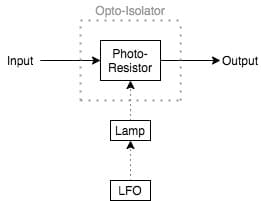
We can see, then, with the signal modulation tremolo design, that the LFO has a direct influence on modulating the signal amplitude!
Of course, there's generally much more to these circuits. However, this is the important part that controls the tremolo effect. Other Parts of the circuit would control other parameters of the overall tremolo effect.
Bias Modulation Tremolo
Bias modulation tremolo is the rarer type of analog tremolo circuit but is certainly worth mentioning in this article.
The bias modulation tremolo circuit uses its LFO to control the bias voltage of a vacuum tube or other type of output preamplifier (typically n-channel JFETs).
Regardless of whether a tube or a transistor is used, the bias modulation tremolo achieves its effect on the same working principle.
Though tubes and JFETs can be used for amplification, they're more so used for attenuation in the context of bias modulation tremolo units.
Let's begin our explanation with an illustration of a simple triode vacuum tube:

- A: anode
- G: grid
- K: cathode
- H: heater
And here's a simple illustration of a junction-gate field-effect transistor (JFET):

- S: source
- G: gate
- D: drain
Other than the heater, which effectively allows the tube to work, the two devices look somewhat similar with three leads.
Triode tubes and JFETs are different electrical components, but they work similarly in the context of many audio devices, including tremolos. The tube's anode, cathode, and grid are somewhat analogous to the source, drain and gate or the JFET, respectively.
The bias voltage is a DC voltage applied to the grid of the tube or gate of the JFET to set a baseline current through the device. The input/program audio signal (AC voltage) is then superimposed on top of the DC bias to control the output audio (AC signal).
The grid or gate, then, controls the current (output voltage) between the anode and cathode or source and drain, respectively.
This is perhaps an oversimplification, but it establishes the basics of the design.
By lowering the DC bias voltage, the output voltage is also dropped. Increasing the DC bias voltage will bring the output voltage up.
The AC voltage (audio signal) will continue to cause a proportionate change in output voltage so long as the tube of JFET isn't overloaded (or underloaded), which would cause distortion.
So then, a bias modulation tremolo effectively sends the program/input signal to the “input” grid|gate of the tube|JFET while also altering the DC bias on the grid|gate via an LFO.
A variable resistor is put in between the DC bias source and the tube/JFET. The resistance/impedance of this resistor is varied via the LFO. Once again, as the resistance/impedance decreases, the DC bias increases and the output level increases. As the resistance/impedance increases, the DC bias decreases, and the output level decreases.
All of this takes place without affecting the input audio signal. Therefore, the output will have the same information as the input signal, only with a varying amplitude (tremolo) effect.
Note that if the bias voltage is too negative, the tubes will cut off. Conversely, if the voltage is too positive, the tube may overheat and burn up in a relatively short amount of time.
Similarly, transistors are not exactly linear when it comes to the gate passing current between the source and drain. Specific values must be met to achieve such a linear region that allows the JFET to behave as a nonlinear resistor.
Digital Tremolo
Digital tremolo units and tremolo plugins work to produce the tremolo effect on digital audio using digital hardware or computer programming, respectively.
These units are often designed to emulate the aforementioned circuits or to modulate the amplitude of the digital signal in other ways.
Digital tremolo units and software plugins are often more versatile due to the powerful nature of digital design and the absence of analog limitations.
This extra versatility/functionality comes in parameters such as clock syncing, tap tempo, and ratio/rhythm controls.
Tremolo Vs. Vibrato
This section is aimed at the guitarists who have been led astray, for I was once one of them myself. Vibrato is not tremolo and tremolo is not vibrato!
Vibrato is defined as the audible modulation of a sound or signal's pitch. Tremolo, as we've discussed, is the audible modulation of a signal's amplitude.
Both effects can be considered “modulation effects” as both effects have their primary modulated parameter (pitch for vibrato and amplitude for tremolo) modulated by a sort of low-frequency oscillator.
So then, the “tremolo arm” or whammy bar of a guitar does not introduce tremolo. Rather, it offers manual pitch variation that resembles the effect of vibrato.
Similarly, the “vibrato” effect built into some guitar amplifiers (the one that modulates the volume of the output signal) is, in reality, the effect of tremolo.
The Fender Tone Master Deluxe Reverb is but one example of an amplifier with a “vibrato” (tremolo) effect.

The labelling of tremolo and vibrato can become tricky in the world of guitar. It’s important, then, to not only know the true definitions of the two effects but also that you’ll likely run into improperly labelled units during your lifetime.
The vibrato vocal technique is sometimes called tremolo if the pitch variations are wide and/or slow. This can also lead to confusion between the two terms. Note that, in this case, tremolo is simply a slower form of vibrato, which is a more common term in singing.
Tremolo Vs. Amplitude Modulation
Technically speaking, tremolo is a style of amplitude modulation since the LFO modulates the amplitude of the program/input signal.
However, the term “amplitude modulation” is associated with radio transmissions for broadcasting and two-way radio communication applications.
With amplitude modulation, an audio signal can have its amplitude be modulated by a carrier signal. The carrier could be a radio frequency, for example, with an audio signal superimposed in it, which is the basis of AM radio transmission.
Note that, unlike tremolo, we cannot perceive any change in amplitude within the output signal at these carrier frequencies.
Here is a simple illustration of how amplitude modulation works with sine waves:

Tremolo Parameters
Now that we understand what tremolo is (and what it's not) and how it works, let's dive into the different parameters that will affect precisely how a tremolo unit will perform.
Tremolo effect units/plugins will often have many (if not all) of the following controls:
Depth/Intensity
The depth/intensity parameter of a tremolo effect unit affects the amplitude of the LFO and, therefore, the amount of amplitude variation the tremolo effect will produce.
A deeper tremolo will cause greater periodic attenuation in the output signal relative to the maximum output.
Rate/Speed
The rate or speed parameter of a tremolo effect unit controls the frequency of the LFO. This, in turn, controls the rate at which the tremolo circuit will drop the amplitude and bring it back up again.
Tap Tempo/Sync Option
Some tremolo units/plugins will allow users the option of synchronizing the effect to the tempo of a project/song. This parameter will switch the speed/rate function (typically defined in Hertz or cycles per second) to note length values (quarter notes, triplet quarter notes, dotted eighth notes, etc.).
Waveform/Shape
Some tremolo effects units allow us to change the waveform of the LFO and effectively alter the style of amplitude modulation.
Typically a tremolo will work with a sine wave LFO. However, we can change the waveform to achieve different styles of tremolo. Other common basic LFO waveforms include the square, triangle and even the sawtooth wave.
Tremolo Effects Unit/Plugin Examples
Before we wrap things up, it’s always a great idea to consider some examples. Let’s have a look at 3 different tremolos to help solidify our understanding of this modulation effect.
In this section, we’ll discuss:
- 500 Series tremolo unit: JHS Kodiak 500
- Tremolo effect pedal: Voodoo Lab Tremolo
- Tremolo plugin: Soundtoys Tremolator
JHS Kodiak 500
The JHS Kodiak 500 is the first fully analog 500 Series tremolo with tap tempo. Unfortunately, it has been discontinued.

As was mentioned, the Kodiak 500 offers an analog tremolo effect with tap tempo control. Choose between tap tempo and expression control via the Exp/Tap toggle switch and use the 1/4″ input to control the speed of the tremolo effect (use the ratio knob to select a note length value according to the tapped tempo).
Alternatively, use the speed control to change the rate of the effect. When using the built-in oscillator to control the modulation, the waveform control allows for continuous morphing of the LFO wave shape.
Adjust the output volume and depth/mix and get a powerful sound from this simple tremolo unit.
Voodoo Lab Tremolo
The Voodoo Lab Tremolo is a superb and straightforward tremolo unit in the stompbox format.

Voodoo Lab’s Tremolo pedal is designed to emulate the smooth warmth of vintage tube amp tremolo. The pedal actually utilizes the same lamp and photocell design found in many popular vintage amps, using light to achieve the amplitude modulation effect.
This true bypass pedal is mono with a single input and output. The controls of the pedal are straightforward:
- Intensity knob: controls the depth of the tremolo effect by adjusting the amplitude of the LFO.
- Slope knob: varies the shape of the tremolo’s LFO waveform from smooth to choppy.
- Speed knob: controls the rate of the tremolo effect by adjusting the frequency of the LFO.
- Volume knob: adjusts the output level of the pedal.
Soundtoys Tremolator
The Soundtoys Tremolator is a plugin that is programmed to emulate the tremolo effect of classic tremolo hardware.

This powerful plugin offers a variety of parameters, including many rhythmic controls. Sync the tremolo to the DAW or tap in your own tempo. Adjust the shape of the modulator along with the groove, feel, and accent, and this tremolo unit will behave much like a sequencer.
Classic tremolo is achieved via the LFO. However, this LFO wave shape can be dialled into our specifications for a perfect tremolo effect.
The typical depth control and input/output levels are featured along with dynamic controls that can turn the effect into a sort of sequenced gate and/or an envelope-following tremolo effect. The input level controls the speed and/or depth of the modulation.
There are many potential effects with this unit that go beyond the typical functionality of a tremolo unit.
Call To Action!
Experiment with tremolo effects, whether they be plugins or hardware. Listen critically to how the modulation changes the sound over time. Adjust the parameters to get a sense of the extremes.
Find and listen to songs that utilize the tremolo effect to really internalize its sound and how it's used.
Have any thoughts, questions or concerns? I invite you to add them to the comment section at the bottom of the page! I'd love to hear your insights and inquiries and will do my best to add to the conversation. Thanks!
Related Questions
What are audio modulation effects? Audio modulation effects manipulate the input audio over time via the control of a carrier signal. The input audio is referred to as the modulator signal, which technically controls the carrier signal, which is generally produced via an oscillator generator or signal detector.
What is the Auto-Pan effect in Ableton Live? Ableton Live's native Auto-Pan plugin is essentially a stereo tremolo effect in which the left and right channel tremolo LFOs can be manipulated to a great degree and interact with one another in a variety of ways.
Related Article
To learn more about modulation effects, check out my article Complete Guide To Audio Modulation Effects (With Examples).

